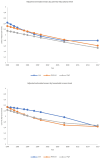Social inequality in the association between life transitions into adulthood and depressed mood: a 27-year longitudinal study
- PMID: 38476482
- PMCID: PMC10929615
- DOI: 10.3389/fpubh.2024.1286554
Social inequality in the association between life transitions into adulthood and depressed mood: a 27-year longitudinal study
Abstract
Background: Few studies have considered the life-course development of depressive symptoms in relation to life transitions in early-adulthood and whether these might affect depressive trajectories differently depending on specific indicators of parental socioeconomic status (SES). In the present work, we explore these questions using the adolescent pathway model as a guiding framework to test socially differential exposure, tracking and vulnerability of the effects of life transitions on depressed mood across different socioeconomic backgrounds.
Methods: Latent growth modeling was used to estimate the associations between indicators of parental SES (parental education and household income) and depressed mood from age 13 to 40 with life transitions (leaving the parental home, leaving the educational system, beginning cohabitation, attaining employment) as pathways between the two. Our analyses were based on a 27-year longitudinal dataset (n = 1242) of a Norwegian cohort with 10 time points in total. To make socioeconomic comparisons, three groups (low, mid, and high) were made for parental education and income respectively.
Results: Depressed mood decreased from age 13 to 40. The low and high parental education groups showed a stable difference in depressed mood during early adolescence, which decreased in young adulthood and then increased slightly in mid-adulthood. The low household income group showed higher depressed mood across young adulthood compared to the medium and higher household income groups. For life transitions, leaving the parental home and beginning cohabitation was associated with an added downturn of the trajectory of depressed mood when adjusting for other transitions. However, adolescents with high parental education showed a relatively stronger decrease in depressed mood when leaving the parental home. Similarly, adolescents with a high household income showed a relatively stronger decrease in depressed mood when leaving the educational system.
Conclusions: Depressed mood decreased over time and developed differently depending on parental education and household income. Life transitions were generally associated with reductions in depressed mood across time, but lower SES youths were not found to be more socially vulnerable these effects.
Keywords: cohabitation; depressed mood; employment; life course; life transitions; moving out; socioeconomic status; the adolescent pathway model.
Copyright © 2024 Jørgensen, Smith, Wold and Haug.
Conflict of interest statement
The authors declare that the research was conducted in the absence of any commercial or financial relationships that could be construed as a potential conflict of interest.
Figures



Similar articles
-
Socioeconomic differences in adolescent health behaviors and their effect on inequalities in adult depressed mood: findings from a 27-year longitudinal study.BMC Psychiatry. 2025 Apr 10;25(1):364. doi: 10.1186/s12888-025-06679-6. BMC Psychiatry. 2025. PMID: 40211254 Free PMC article.
-
Is adolescent multiple risk behaviour associated with reduced socioeconomic status in young adulthood and do those with low socioeconomic backgrounds experience greater negative impact? Findings from two UK birth cohort studies.BMC Public Health. 2021 Sep 3;21(1):1614. doi: 10.1186/s12889-021-11638-3. BMC Public Health. 2021. PMID: 34479524 Free PMC article.
-
Associations of early adulthood life transitions with changes in fast food intake: a latent trajectory analysis.Int J Behav Nutr Phys Act. 2020 Oct 9;17(1):130. doi: 10.1186/s12966-020-01024-4. Int J Behav Nutr Phys Act. 2020. PMID: 33036629 Free PMC article.
-
A systematic review of depressed mood and anxiety by SES in youth aged 10-15 years.Can J Public Health. 2008 Mar-Apr;99(2):125-9. doi: 10.1007/BF03405459. Can J Public Health. 2008. PMID: 18457287 Free PMC article.
-
Changes in physical activity, diet, and body weight across the education and employment transitions of early adulthood: A systematic review and meta-analysis.Obes Rev. 2020 Apr;21(4):e12962. doi: 10.1111/obr.12962. Epub 2020 Jan 19. Obes Rev. 2020. PMID: 31955496 Free PMC article.
References
Publication types
MeSH terms
LinkOut - more resources
Full Text Sources

